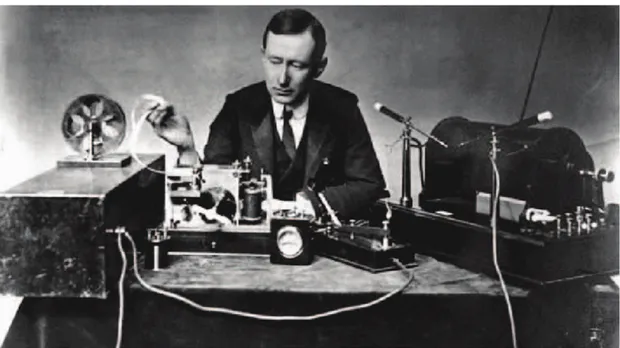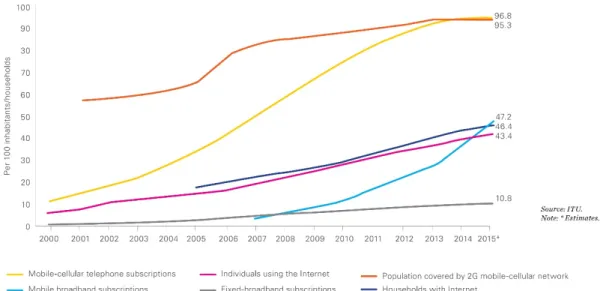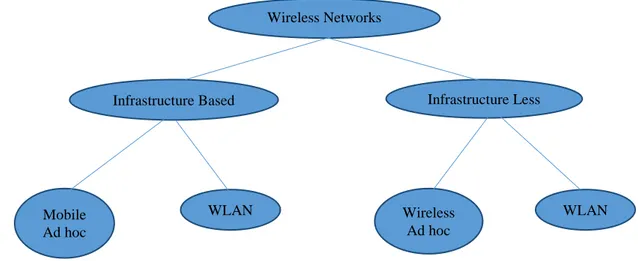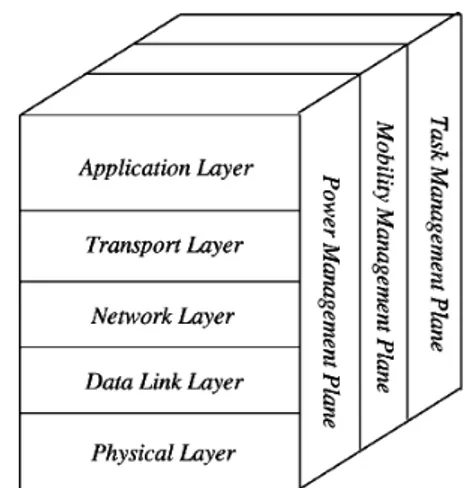Wireless Communication and its Technical Issues
Authors:
Danish Naveed
Dr. Abbas Khurum
Abstract:
Wireless communication is the transfer of information between two or more nodes that are not connected directly through the cable network or by any other physi-cal/tangible way of conducting electrical signals or light signals such as fiber optics. This report provides systematic tutorial of wireless technologies and its issues.
Introduction
Wireless communication is the transfer of information between two or more nodes that are not connected directly through the cable network or by any other physi-cal/tangible way of conducting electrical signals or light signals such as fiber optics.
1.1 Introduction to Wireless Communications & Networks
Radio waves are most commonly used by the common wireless technologies. Radio waves are the most flexible way to communicate over range of small distance such as in rooms to the large distances such as deep space communications between distant planets. In reality of approximately last 6 decades, considering few examples of real life communication, such as a few meters for television or as far as thousands or even millions of kilometers for deep-space radio communications. It encompasses various types of fixed, mobile, and portable applications, including two-way radios, cellular telephones, personal digital assistants (PDAs), and wireless networking. Other exam-ples of applications of radio wireless technology include GPS units, garage door openers, wireless computer mice, keyboards and headsets, headphones, radio receiv-ers, satellite television, broadcast television and cordless telephones.
Somewhat less common methods of achieving wireless communications include the use of other electromagnetic wireless technologies, such as light, magnetic, or electric fields or the use of sound. In these technologies microwaves are the most common that are used for information exchange. Communicating through these waves is totally a game of energy and power.
As a matter of fact we are now enslaved with the wireless communications by consid-ering it as our master because we are getting ourselves buried with gadgets capable of communicating wirelessly. A few of exemplary wireless gadgets are Mouse, key-board, hands free, pocket TV, wireless sensors, controllers, etc. etc.
The term wireless has been used twice in communications history, with slightly dif-ferent meaning. It was initially used from about 1890 for the first radio transmitting and receiving technology, as in wireless telegraphy, until the new word radio replaced it around 1920. The term was revived in the 1980s and 1990s mainly to distinguish digital devices that communicate without wires, such as the examples listed in the previous paragraph, from those that require wires. This is its primary usage today.
1.2 History
1.2.1 Photophone
The world's first wireless telephone conversation occurred in 1880, when Alexander Graham Bell and Charles Sumner Tainter invented and patented the photophone, a telephone that conducted audio conversations wirelessly over modulated light beams (which are narrow projections of electromagnetic waves). In that distant era, when utilities did not yet exist to provide electricity and lasers had not even been imagined in science fiction, there were no practical applications for their invention, which was highly limited by the availability of both sunlight and good weather. Similar to free-space optical communication, the photophone also required a clear line of sight be-tween its transmitter and its receiver. It would be several decades before the photophone's principles found their first practical applications in military communica-tions and later in fiber-optic communicacommunica-tions.
1.2.2 Early wireless work
David E. Hughes transmitted radio signals over a few hundred yards using a clock-work keyed transmitter in 1878. As this was before Maxwell's clock-work was understood,
Hughes' contemporaries dismissed his achievement as mere "Induction." In 1885, Thomas Edison used a vibrator magnet for induction transmission. In 1888, Edison deployed a system of signaling on the Lehigh Valley Railroad. In 1891, Edison ob-tained the wireless patent for this method using inductance.
1.2.3 Radio
The term "wireless" came into public use to refer to a radio receiver or transceiver (a dual purpose receiver and transmitter device), establishing its use in the field of wire-less telegraphy early on; now the term is used to describe modern wirewire-less connec-tions such as in cellular networks and wireless broadband Internet. It is also used in a general sense to refer to any operation that is implemented without the use of wires, such as "wireless remote control" or "wireless energy transfer", regardless of the spe-cific technology (e.g. radio, infrared, ultrasonic) used. Guglielmo Marconi and Karl Ferdinand Braun were awarded the 1909 Nobel Prize for Physics for their contribu-tion to wireless telegraphy.
1.3 History in technical aspects
1.3.1 Radio and Transoceanic Communication
In 1896, Guglielmo Marconi (Figure 1) developed the first wireless telegraph system. In December 1901, he used his system for transmitting the first wireless signals across the Atlantic between Poldhu, Cornwall, and St. John's, Newfoundland, a distance of 2,100 miles [1].
Figure 1.1. Marconi operating an apparatus similar to that used by him to transmit the first wireless signal across the Atlantic in 1901. (Source: Wikimedia Commons.)
Edwin Armstrong (Figure 3) was one of the most prolific inventors of the radio era, with a vision that was ahead of his time [2] [3] [4] [5] [6]. He invented the regenera-tive circuit (invented while he was a junior in college at Columbia University, New York City, and patented 1914), the superregenerative circuit (patented 1922), and the superheterodyne receiver (patented 1918). Armstrong had realized that higher-frequency equipment would allow detection of enemy shipping much more effective-ly, but at the time, no practical short-wave amplifier existed. In those days “short wave” meant anything above 500 KHz. Armstrong mixed the high-frequency signal down to a lower frequency, which was far more amenable to high-gain amplification using triodes.
1.3.2 Radar and Transistor Development
Radar can be traced back to the work of Heinrich Hertz in the late 19th century that showed that radio waves were reflected by metallic objects. This possibility was sug-gested in James Clerk Maxwell's seminal work on electromagnetism [7]. Christian Hülsmeyer, the German inventor, built and demonstrated on 9 June 1904 a simple ship detection device intended to help avoid collisions in fog [8].
In the 1934–1939 period, eight nations developed, independently and in great secrecy, radar systems: the United States, Great Britain, Germany, the USSR, Japan, The Netherlands, France, and Italy. In addition, Great Britain had shared their basic infor-mation with four Commonwealth countries: Australia, Canada, New Zealand, and South Africa, and these countries had also developed indigenous radar systems. Dur-ing the war, Hungary was added to this list [9].
The term “RADAR” was coined in 1940 by the United States Signal Corps as an ac-ronym for radio detection and ranging. The range of the object is obtained by measur-ing the time difference between the return signal and transmitted signal, while the ve-locity of the object is determined by the difference between the received frequency and the transmitted frequency of the signal (Doppler frequency shift) [10]. Figure 4 shows a large radar antenna used to track space objects as well as ballistic missiles. In 1947, the transistor was invented by scientists John Bardeen, Walter Brattain, and William Shockley (Figure 5) who later shared the Nobel Prize [11]. The transistor
re-placed vacuum tubes, serving as the foundation for the development of modern elec-tronics and making possible the marriage of computers and communications.
1.3.3 Technology in 15 years
Last 15 years of technology in wireless communication is evolving like a change in day to night. Years ago no one expect this huge change will take place. But now a days researchers think this is not enough this needs more and more enhancements. With technology updates in wireless communication there comes new generation of this communications such as 2nd generation wireless network similarly 2.5G, 3G and now a days new generation 4G in replacement to the concept of NGN (New Genera-tion Network). People want to enhance their communicaGenera-tion devices for better trans-mission & internet usage.
Last year a survey report was published by The ITU (International Telecommunica-tion Union) based on ICT (InformaTelecommunica-tion and CommunicaTelecommunica-tion Technology) in which they show the use of modern communication devices as public use in last 15 years as shown in Figure 2,3 & 4 given below
Figure 2 15 years of ICT growth: what has been achieved?
In the same report ITU testified the number of illiterates developing their interests in use of cellular communication in rural areas. Rather than the population in urban are-as. In short rural population is the winner of their interest development in modern communication era than the urban population. Their comparison is shown in Figure 4.
.
1.4 Problems in Wireless Communication
In the seventies, the principal design problem encountered in wireless or mobile radio was how to overcome the distortion of received signals by a time-varying and frequency-selective propagation path. Radio waves near the ground do not travel over a single well-defined radio path as in free space; they are scattered against reflecting obstacles in the vicinity of the mobile antenna. Reflected waves may add destructively, causing the received signal to disappear or become heavily attenuated at certain locations. A moving user, as in vehicular telephony, receives a resulting signal that is rapidly varying in time. This effect is called `fading'. Moreover, waves excessively delayed by remote reflections cause distortion of the shape of transmitted waveforms.
Modern (digital) signal processing (DSP-)techniques can mitigate these effects to a great extent. As a result, nowadays the most quoted critical issues of wireless systems are no longer directly related to multipath fading, but are
• the scarcity of radio spectrum and the resulting mutual interference among users
• the power consumption of portable terminals and the inadequacy of existing battery and other energy storage technologies, and
• the complexity of the software needed to support user mobility, e.g. from cell to cell or from operator to operator.
1.4.1 Security
The main issue that is not discussed anywhere else in old research is security. In old times no one was concerned with the security issues because there was minimum at-tack flux on wireless communication, that minimum so no one cares if few atat-tacks occur. These attacks don’t effect that much that cause to think about the security. In last two decade and modern communication security is the main issue, because the interest of attacker has been developed by few things. Such as
• Money • Popularity • Learning • Revenge • Etc.
1.5 Issues with technical aspect
Mobile communications and wireless networking technology has seen a thriving de-velopment in recent years. Driven by technological advancements as well as applica-tion demands various classes of communicaapplica-tion networks have emerged such as Cel-lular networks, Ad hoc Networks, Sensor Networks and Mesh Networks.
Cellular Networks are the infrastructure dependent networks. Ad hoc networks are defined as the category of wireless networks that utilize multi hop radio relaying since the nodes are dynamically and arbitrarily located. Ad hoc networks are infrastructure independent networks [12].
So what’s a Wireless Sensor Network (WSN)? We have different viewpoints for this question. According to Akylidiz et al., WSN consists of large number of nodes that are deployed in such a way that they can sense the phenomena [13]. Akkaya and Younis define WSN as a network that consists of small nodes with sensing, computa-tion and communicacomputa-tion capabilities [14]. Now with consideracomputa-tion of these two defini-tions we can classify it as special class of wireless ad hoc networks. Even though sen-sor networks are a special type of ad hoc networks, the protocols designed for ad hoc networks cannot be used as it is for sensor networks due to following reasons:
I. The number of nodes in sensor networks is very large and has to scale to several orders of magnitude more than the ad hoc networks and thus require different and more scalable solutions.
II. The data rate is expected to be very low in WSN and is of statistical in nature. But mobile ad hoc network (MANET) is designed to carry rich multimedia data and is mainly deployed for distributed computing.
III. A sensor network is usually deployed by a single owner but MANET is usually run by several unrelated entities. [15]
IV. Sensor networks are data centric i.e. the queries in sensor network are addressed to nodes which have data satisfying some conditions and unique addressing is not possible as they do not have global identifiers. But MANET is node centric, with queries addressed to particular nodes specified by their unique addresses.
V. Sensor nodes are usually deployed once in their life time and those nodes are generally stationary except a few mobile nodes, while nodes in MANET move in an ad hoc manner.
VI. Like MANET sensor nodes are also designed for self-configuration, but the difference in traffic and energy consumption require separate solutions. In comparison to ad hoc networks, sensor nodes have limited power supply and recharge of power is impractical considering the large number of nodes and the environment in which they are deployed. Therefore energy consumption in WSN is an important metric to be considered.
VII. Sensor networks are application specific. One can’t have a solution that fits for all the problems.
VIII. Simplicity is the rule in the WSN. Since sensor nodes are small and there is restriction on energy consumption; the communicating and computing software in the nodes should be of less size and computation efficient than the traditional software used for the same purpose.
Sensor networks have been proposed for a variety of application [13] [16] [17] like Intrusion detection and tracking for military purpose, habitat monitoring, motion detection for understanding earthquake patterns and to prevent theft, health application by monitoring the drug administered to the patients and for traffic analy-sis.
1.5.1 Various Issues
The major issues that affect the design and performance of a wireless sensor network are as follows:
1) Hardware and Operating System for WSN 2) Wireless Radio Communication Characteristics 3) Medium Access Schemes
4) Deployment 5) Localization 6) Synchronization 7) Calibration 8) Network Layer 9) Transport Layer
10) Data Aggregation and Data Dissemination 11) Database Centric and Querying
12) Architecture
13) Programming Models for Sensor Networks 14) Middleware
15) Quality of Service 16) Security
There are many types of wireless networks as discussed in Introduction to Wireless communications. These communication took place through a defined networks with standards. Such as standards gives abilities to sense and signal other devices when the devices has same language, phase and time to synchronize. Similarly a standard divi-sion of wireless networks took place known as networks classification as shown in
figure below
Ad hoc networks sub classified in to two types of networks 1. Single Hop
2. Multi Hop
Simple direct communication and transmission is known as single Hop ad hoc Net-work doesn’t need complex protocols as shown in figure
Wireless Networks
Infrastructure Based Infrastructure Less
Mobile Ad hoc
WLAN Wireless
Ad hoc
WLAN
Figure 1.5 Taxonomy of Wireless Networks
A A
Similarly in multi hop networks there exist multiple nodes but need routing protocols for communication as well as in multi hop layer 3 is considered so as the infrastruc-ture is required we can say this is infrastrucinfrastruc-ture based wireless ad hoc network. As shown below
As well as security is concerned there are many attacks possible that can take place using these issues, discussed in this chapter in topic 1.5.1. Few of attacks that can take place are listed as
Black Hole Attack Wormhole Attack Byzantine Attack Sleep Deprivation Location Disclosure Eavesdropping Flooding Attack a. RREQ Flooding b. Data Flooding S 1 2 3 1 2 3 D
As the concern of Black Hole attacks in multi hop wireless ad hoc network. We need to discuss the attack impact. This attack is fully dependent on layer 3 (The Network Layer). Because routing and sinking both are properties of this attack.
Further technical points and significance of this attack will be discussed in next chapter.
1.7 Purpose of Project
To learn about attack in aggressive modes so that we can rate every threat according to different target points and do some impact evaluation in different scenarios. When I got expert in this being an attacker I’ll be with knowledge of a good attacker so I have points to mitigate now mitigations is getting easier.
1.8 Scope of Research
To be explained.
Figure 1.5 Protocol Stack Figure 1.4 Black Hole Attack
References
[1] Z. Haider, M. Saleem, and T. Jamal, "Analysis of Interference in Wireless", in Proc. of ArXiv, arXiv:1810.13164 [cs.NI], Oct. 2018.
[2] T. Jamal and P. Mendes, “Relay Selection Approaches for Wireless Cooperative Networks”, in Proc. of IEEE WiMob, Niagara Falls, Canada, Oct. 2010.
[3] T. Jamal, P. Mendes, and A. Zúquete, “Opportunistic Relay Selection for Wireless Cooperative Network”, in Proc. of IEEE IFIP NTMS, Istanbul Turkey, May 2012. [4] T. Jamal and P. Mendes, “Cooperative relaying in user-centric networking under interference conditions”, in Proc. of IEEE Communications Magazine, vol. 52, no. 12, pp. 18–24, Dec 2014.
[5] P. Mendes, W. Moreira, T. Jamal, and Huiling Zhu, “Cooperative Networking in User-Centric Wireless Networks”, In: Aldini A., Bogliolo A. (eds) User-Centric Net-working. Lecture Notes in Social Networks. Springer, Cham, ISBN 978-3-319- 05217-5, May 2014.
[6] T. Jamal, P. Mendes, and A. Zúquete, “Relayspot: A Framework for Opportunistic Cooperative Relaying”, in Proc. of IARIA ACCESS, Luxembourg, June 2011.
[7] T. Jamal, and SA Butt, "Malicious Node Analysis in MANETS", in Proc. of Inter-national Journal of Information Technology, PP. 1-9, Springer Publisher, Apr. 2018. [8] T. Jamal, and P. Mendes, “COOPERATIVE RELAYING FOR DYNAMIC NETWORKS”, EU PATENT, (EP13182366.8), Aug. 2013.
[9] T. Jamal, and P. Mendes, “802.11 Medium Access Control In MiXiM”, in Proc. of Tech Rep. SITILabs-TR-13-02, University Lusófona, Lisbon Portugal, Mar. 2013. [10] T Jamal, M Alam, and MM Umair, "Detection and Prevention Against RTS At-tacks in Wireless LANs", in Proc. of IEEE C-CODE, Islamabad Pakistan, Mar. 2017. [11] L. Lopes, T. Jamal, and P. Mendes, "Towards Implementing Cooperative Relay-ing", In Proc. of Technical Report COPE-TR-13-06, CopeLabs University Lusofona Portugal, Jan 2013.
[12] T. Jamal, P. Mendes, and A. Zúquete, “Interference-Aware Opportunistic Relay Selection”, In Proc. of ACM CoNEXT student workshop, Tokyo, Japan, Dec. 2011. [13] T. Jamal, "Cooperative MAC for Wireless Network", In Proc. of 1st MAP Tele Workshop, Porto, Portugal, 2010.
[14] T. Jamal and P. Mendes, “Analysis of Hybrid Relaying in Cooperative WLAN”, In Proc. of IEEE IFIP Wireless Days (WD), Valencia, Spain, November 2013.
[15] T. Jamal, and P. Mendes, “Cooperative Relaying for Wireless Local Area Net-works”, In: Ganchev I., Curado M., Kassler A. (eds) Wireless Networking for Moving Objects. Lecture Notes in Computer Science, vol 8611. Springer, Cham, (WiNeMo), Aug. 2014.
[16] T. Jamal, and SA Butt, “Cooperative Cloudlet for Pervasive Networks”, in Proc. of Asia Pacific Journal of Multidisciplinary Research, Vol. 5, No. 3, PP. 42-26, Aug 2017.
[17] T. Jamal, P. Mendes, and A. Zúquete, “Wireless Cooperative Relaying Based on Opportunistic Relay Selection”, in Proc. of International Journal on Advances in Networks and Services, Vol. 5, No. 2, PP. 116-127, Jun. 2012.
[18] SA Butt, and T. Jamal, “Frequent Change Request from User to Handle Cost on Project in Agile Model”, in Proc. of Asia Pacific Journal of Multidisciplinary Re-search 5 (2), 26-42, 2017.
[19] T. Jamal, and P. Amaral, “Flow Table Congestion in Software Defined Net-works”, in Proc. of IARIA 12th ICDS, Rome Italy, Mar. 2018.
[20] R. Sofia, P. Mendes, W. Moreira, A. Ribeiro, S. Queiroz, A. Junior, T. Jamal, N. Chama, and L. Carvalho, “Upns: User Provided Networks, technical report: Living-Examples, Challenges, Advantages”, Tech. Rep. SITI-TR-11- 03, Research Unit in Informatics Systems and Technologies (SITI), University Lusofona, Lisbon Portugal, Mar. 2011.
[21] T. Jamal, and P. Mendes, “Cooperative Relaying in Wireless User-Centric Net-works”, Book Chapter In: Aldini, A., Bogliolo, A. (eds.) User Centric Networking. Lecture Notes in Social Networks, Springer, Cham, pp. 171–195, 2014.
[22] T. Jamal, P. Mendes, and A. Zúquete, “Design and Performance of Wireless Co-operative Relaying”, PhD Thesis MAP-Tele, University of Aveiro, Oct. 2013.
[23] T. Jamal, P. Mendes, and A. Zuquete, “RelaySpot: Cooperative Wireless Relay-ing”, in Proc. of MAP-Tele Workshop, Aveiro, Portugal, May 2011.
[24] T. Jamal, and P. Mendes, “Cooperative Wireless Relaying, Key Factors for Relay Selection”, in Proc. of MAP-Tele Workshop, Porto, Portugal, Dec. 2009.
[25] SA Butt, and T. Jamal, “Study of Black Hole Attack in AODV”, in Proc. of In-ternational Journal of Future Generation Communication and Networking, Vol. 10, No.9, pp. 37-48, 2017.
[26] T. Jamal, and SA Butt, “Low-Energy Adaptive Clustering Hierarchy (LEACH) Enhancement for Military Security Operations”, In Proc. Of Journal of Basic and Ap-plied Scientific Research, ISSN 2090-4304, 2017.
[27] T. Jamal, and P. Mendes, “RelaySpot, OMNET++ Module”, Software Simulator Extension In Proc. of COPE-SW-13-05, 2013.
[28] T. Jamal and Z. Haider, "Denial of Service Attack in Cooperative Networks", in Proc. of ArXiv, arXiv: CoRR Vol. arXiv:1810.11070 [cs.NI], Oct. 2018.
[29] M. Asam and T. Jamal, "Security Issues in WBANs", in proc of Arxiv, Volume arXiv:1911.04330 [cs.NI], November 2019.
[30] M. Asam and Z. Haider, "Novel Relay Selection Protocol for Cooperative Net-works", in proc of Arxiv, Volume arXiv: 1911.07764 [cs.NI], November 2019. [31] SA Butt and T. Jamal, "A multivariant secure framework for smart mobile health application", in Transactions on Emerging Telecommunications Technologies, Aug. 2019.
[32] S. A. Butt, T. Jamal, and M. Shoaib, "IoT Smart Health Security Threats," in proc. of 19th International Conference on Computational Science and Its Applications (ICCSA), Saint Petersburg, Russia, 2019, pp. 26- 31. doi: 10.1109/ICCSA.2019.000-8.
[33] M. Asam and A. Ajaz, “Challenges in Wireless Body Area Network”, in Proc. of International Journal of Advanced Computer Science and Applications, Volume 10, No. 11, Nov. 2019.
[34] SA Butt and T. jamal, "Predictive Variables for Agile Development Merging Cloud Computing Services", in Proc. of IEEE Access, Volume 7, 2019. DOI: 10.1109/ACCESS.2019.2929169.
[35] T Jamal, P Amaral, A Khan, SAB, Kiramat, "Denial of Service Attack in Wire-less LAN", in Proc of 12th ICDS 2018, Rome Italy.




